Van Kreveld M., Nievergelt J., Roos T., Widmayer P. (eds.) Algorithmic Foundations of Geographic Information Systems
Подождите немного. Документ загружается.


one gets 2.35, an error of less than 1%. For a less needle-like triangle with a =
6.9, b = 3.68, and c = 3.48 the improvement is not so drastic. Using the first
expression, the result computed by a floating-point system with base 10, mantissa
length 3 and exact rounding is 3.36. The second expression gives 3.3. The exact
area is approximately 3.11. One can show that the relative error of the second
expression is at most 11 times machine precision [46].
As the example above shows, the way a numerical value is computed can
highly influence its precision. Summation of floating-point numbers is another
classical example. Rearranging the summands helps to reduce imprecision due
to extinction.
2.5 Heuristic Epsilons
A widely used method to deal with numerical inaccuracies is based on the rule
of thumb
If something is close to zero it is zero.
Some trigger-value Cm~gic is added to a conditional test where a numerical value
is compared to zero. If the computed approximation is smaller than gmagic it
is treated as zero. Adding such epsilons is popular folklore. What should the
Cm~gi¢ be? In practice, gmagic is usually chosen as some fixed tiny constant and
hence not sensitive to the actual sizes of the operands in a concrete expression.
Furthermore, the same epsilon is often taken for all comparisons, no matter
which expression or which predicate is being evaluated. Normally, no proof is
given that the chosen ~magi¢ makes sense, e~,~gi~ is guessed and adjusted by
trial and error until the current value works for the considered inputs, i.e., until
no catastrophic errors occur anymore. Yap [114] suggests calling this procedure
epsilon-tweaking.
Adding epsilon is justified by the following reasoning: If something is so close
to zero, then a small modification of the input, i.e., a perturbation of the numeri-
cal data by a small amount, would lead to value zero in the evaluated expression.
There are, however, severe problems with that reasoning. The size of the per-
turbation causes a problem. The justification for adding epsilons assumes that
the perturbation of the (numerical) input is small. Even if such a small pertur-
bation exists for each predicate, the existence of a global small perturbation of
the input data is not guaranteed. Figure 4 shows a polyline, where every three
consecutive vertices are collinear under the "close to zero is zero" rule. In each
J
J
Fig. 4. A locally straight line
case, a fairly small perturbation of the points exists that makes them collinear.
263

There is, however, no small perturbation that makes the whole polyline straight.
The example indicates that collineaxity is not transitive. Generally, equality is
not transitive under epsilon-tweaking. This might be the most serious problem
with this approach. Another problem is that different tests might require dif-
ferent perturbations, e.g., predicate P1 might require a larger value for input
variable x56 while test P2 requires a smaller value, such that both expressions
evaluate to zero. There might be no perturbation of the input data that leads to
the decisions made by the "close to zero is zero" rule. Finally, a result computed
with "close to zero is zero" is not the exact result for the input data but only
for a perturbation of it. For some geometric problems that might cause trouble,
since the computed output and the exact output can be combinatorialty very
different [t5].
3 Exact Geometric Computation
An obvious approach to the precision problem is to compute "exactly". In this
approach the computation model over the reals is mimiced in order to preserve
the theoretical correctness proof. Exact computation means to ensure that all
decisions made by the algorithm are correct decisions for the actual input, not
only for some perturbation of it. As we shall see, it does not mean that in all
calculations exact representations for all numerical values have to be computed.
Approximations that are suËficiently close to the exact value can often be used
to guarantee the correctness of a decision. Empirically it turns out to be true
for most of the decisions made by a geometric algorithm that approximations
are suffÉcient. Only degenerate and nearly degenerate situations cause problems.
That is why most implementations based on floating-point numbers work very
well for the majority of the considered problem instances and fail only occasion-
ally.
If an implementation of an algorithm does all branchings the saxne way as
its theoretical counterpart, the control flow in the implementation corresponds
to the control flow of the algorithm proved to be correct under the assumption
of exact computation over the reals, and hence the validity of the combinatorial
part of the computed output follows. Thus, for selective geometric problems, it
is sufficient to guarantee correct decisions, since all numerical data are already
part of the input.
For constructive geometric problems, new numerical data have to be com-
puted "exactly". A representation of a real number r should be called exact
only if it altows one to compute an approximation of r to whatever precision,
i.e. no information has been lost. According to Yap [114] a representation of a
subset of the reals is exact if it allows the exact comparison of any two real num-
bers in that representation. This reflects the necessity for correct comparisons
in branchings steps in the exact geometric computation approach. Examples of
exact representations are the representation of rationals by numerator and de-
nominator, where both are arbitrary precision integers, and the representation
of algebraic numbers by an integral polynomial P having root a and an interval
264
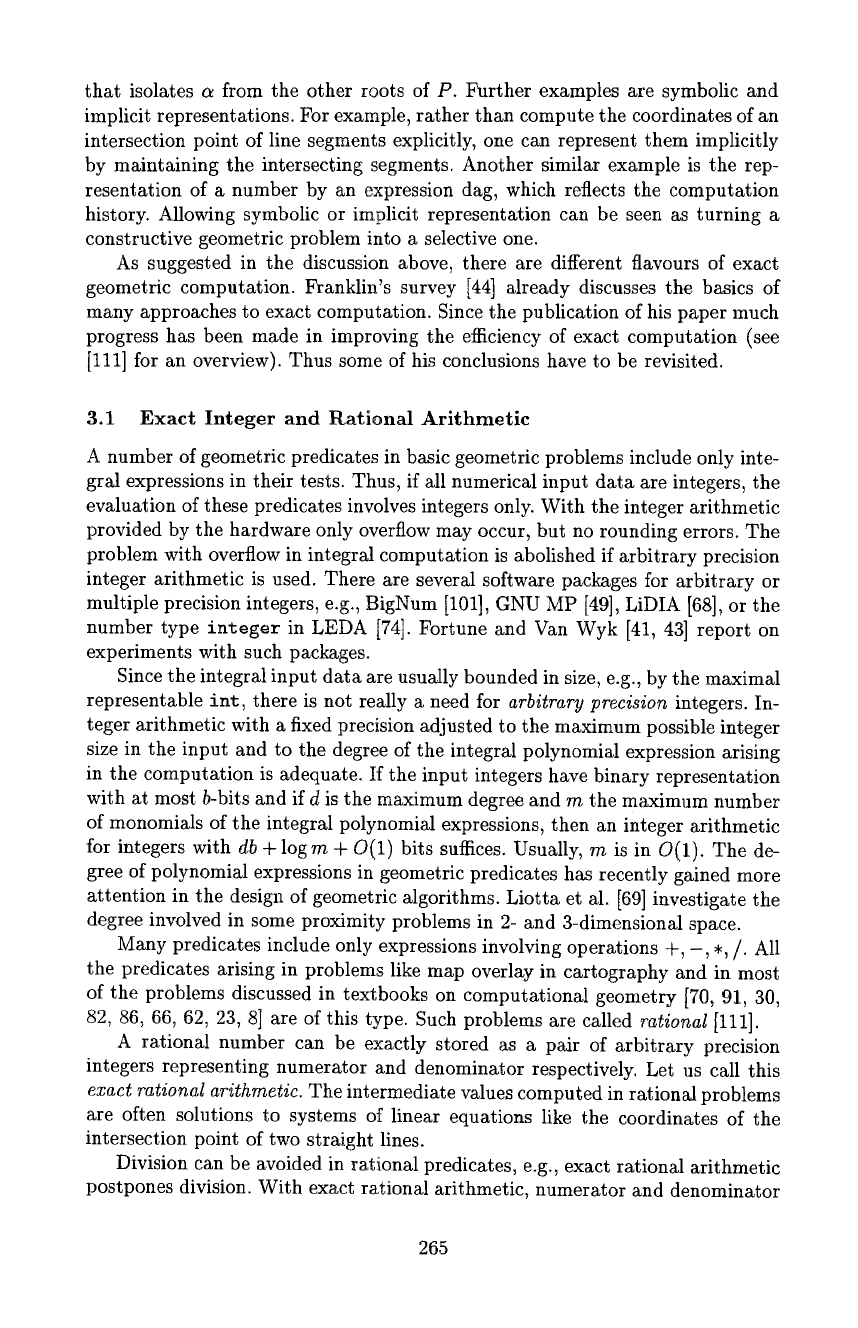
that isolates c~ from the other roots of P. Further examples are symbolic and
implicit representations. For example, rather than compute the coordinates of an
intersection point of line segments explicitly, one can represent them implicitly
by maintaining the intersecting segments. Another similar example is the rep-
resentation of a number by an expression dag, which reflects the computation
history. Allowing symbolic or implicit representation can be seen as turning a
constructive geometric problem into a selective one.
As suggested in the discussion above, there are different flavours of exact
geometric computation. Franklin's survey [44] already discusses the basics of
many approaches to exact computation. Since the publication of his paper much
progress has been made in improving the efficiency of exact computation (see
[111] for an overview). Thus some of his conclusions have to be revisited.
3.1 Exact Integer and Rational Arithmetic
A number of geometric predicates in basic geometric problems include only inte-
gral expressions in their tests. Thus, if all numerical input data are integers, the
evaluation of these predicates involves integers only. With the integer arithmetic
provided by the hardware only overflow may occur, but no rounding errors. The
problem with overflow in integral computation is abolished if arbitrary precision
integer arithmetic is used. There are several software packages for arbitrary or
multiple precision integers, e.g., BigNum [101], GNU MP [49], LiDIA [68], or the
number type integer in LEDA I74]. Fortune and Van Wyk [41, 43] report on
experiments with such pacl~ges.
Since the integral input data are usually bounded in size, e.g., by the maximal
representable int, there is not really a need for
arbitrary precision
integers. In-
teger arithmetic with a fixed precision adjusted to the maximum possible integer
size in the input and to the degree of the integral polynomial expression arising
in the computation is adequate. If the input integers have binary representation
with at most b-bits and if d is the maximum degree and m the maximum number
of monomials of the integral polynomial expressions, then an integer arithmetic
for integers with
db +
logm + O(1) bits suffices. Usually, m is in O(1). The de-
gree of polynomial expressions in geometric predicates has recently gained more
attention in the design of geometric algorithms. Liotta et al. [69] investigate the
degree involved in some proximity problems in 2- and 3-dimensional space.
Many predicates include only expressions involving operations +, -, ,,/. All
the predicates arising in problems like map overlay in cartography and in most
of the problems discussed in textbooks on computational geometry [70, 91, 30,
82, 86, 66, 62, 23, 8] are of this type. Such problems are called
rational
[111].
A rational number can be exactly stored as a pair of arbitrary precision
integers representing numerator and denominator respectively. Let us call this
exact rational arithmetic.
The intermediate values computed in rational problems
are often solutions to systems of linear equations like the coordinates of the
intersection point of two straight lines.
Division can be avoided in rational predicates, e.g., exact rational arithmetic
postpones division. With exact rational arithmetic, numerator and denominator
265
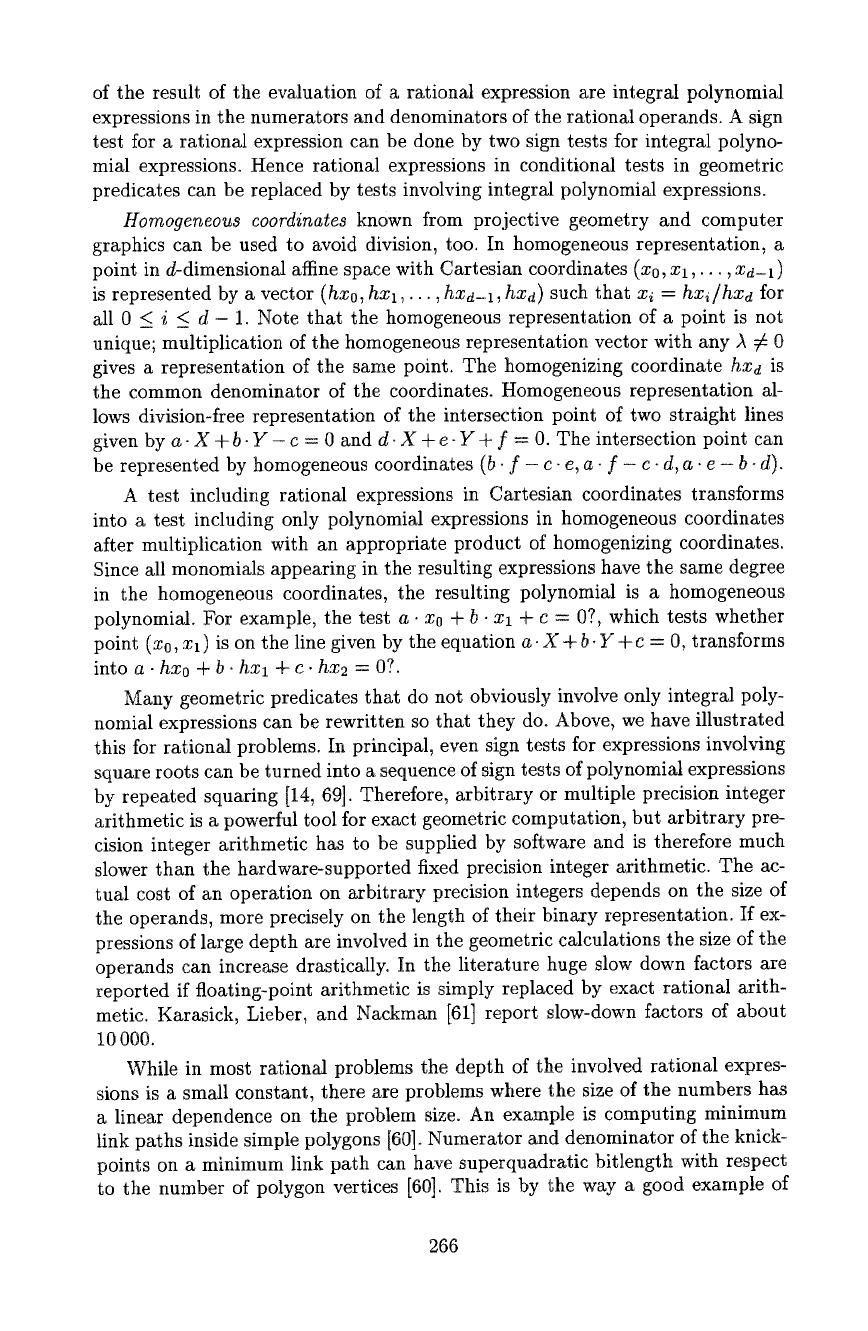
of the result of the evaluation of a rational expression are integral polynomial
expressions in the numerators and denominators of the rational operands. A sign
test for a rational expression can be done by two sign tests for integral polyno-
mial expressions. Hence rational expressions in conditional tests in geometric
predicates can be replaced by tests involving integral polynomial expressions.
Homogeneous coordinates
known from projective geometry and computer
graphics can be used to avoid division, too. In homogeneous representation, a
point in d-dirnensional affine space with Cartesian coordinates (x0,
xl,..., Xd-1)
is represented by a vector
(hxo, hXl,..., hxd-1, hx~)
such that
x~ = hx~/hXd
for
all 0 < i < d - 1. Note that the homogeneous representation of a point is not
unique; multiplication of the homogeneous representation vector with any A ~ 0
gives a representation of the same point. The homogenizing coordinate
hxd
is
the common denominator of the coordinates. Homogeneous representation al-
lows division-free representation of the intersection point of two straight lines
given by a- X + b. Y - c = 0 and d. X + e- Y + f = 0. The intersection point can
be represented by homogeneous coordinates (b. f - c. e, a. f - c- d, a. e - b- d).
A test including rational expressions in Cartesian coordinates transforms
into a test including only polynomial expressions in homogeneous coordinates
after multiplication with an appropriate product of homogenizing coordinates.
Since all monomials appearing in the resulting expressions have the same degree
in the homogeneous coordinates, the resulting polynomial is a homogeneous
polynomial. For example, the test a • x0 + b • xl + c = 07, which tests whether
point (x0, xl) is on the line given by the equation a-X + b. Y + c = 0, transforms
into
a . hxo + b. hxl + c. hx2 =
0?.
Many geometric predicates that do not obviously involve only integral poly-
nomial expressions can be rewritten so that they do. Above, we have illustrated
this for rational problems. In principal, even sign tests for expressions involving
square roots can be turned into a sequence of sign tests of polynomial expressions
by repeated squaring [14, 69]. Therefore, arbitrary or multiple precision integer
arithmetic is a powerful tool for exact geometric computation, but arbitrary pre-
cision integer arithmetic has to be supplied by software and is therefore much
slower than the hardware-supported fixed precision integer arithmetic. The ac-
tual cost of an operation on arbitrary precision integers depends on the size of
the operands, more precisely on the length of their binary representation. If ex-
pressions of large depth are involved in the geometric calculations the size of the
operands can increase drastically. In the literature huge slow down factors are
reported if floating-point arithmetic is simply replaced by exact rational arith-
metic. Karasick, Lieber, and Nackman [61] report slow-down factors of about
I0
000.
While in most rational problems the depth of the involved rational expres-
sions is a small constant, there are problems where the size of the numbers has
a linear dependence on the problem size. An example is computing minimum
tink paths inside simple polygons [60]. Numerator and denominator of the knick-
points on a minimum link path can have superquadratic bitlength with respect
to the number of polygon vertices [60]. This is by the way a good example of
266
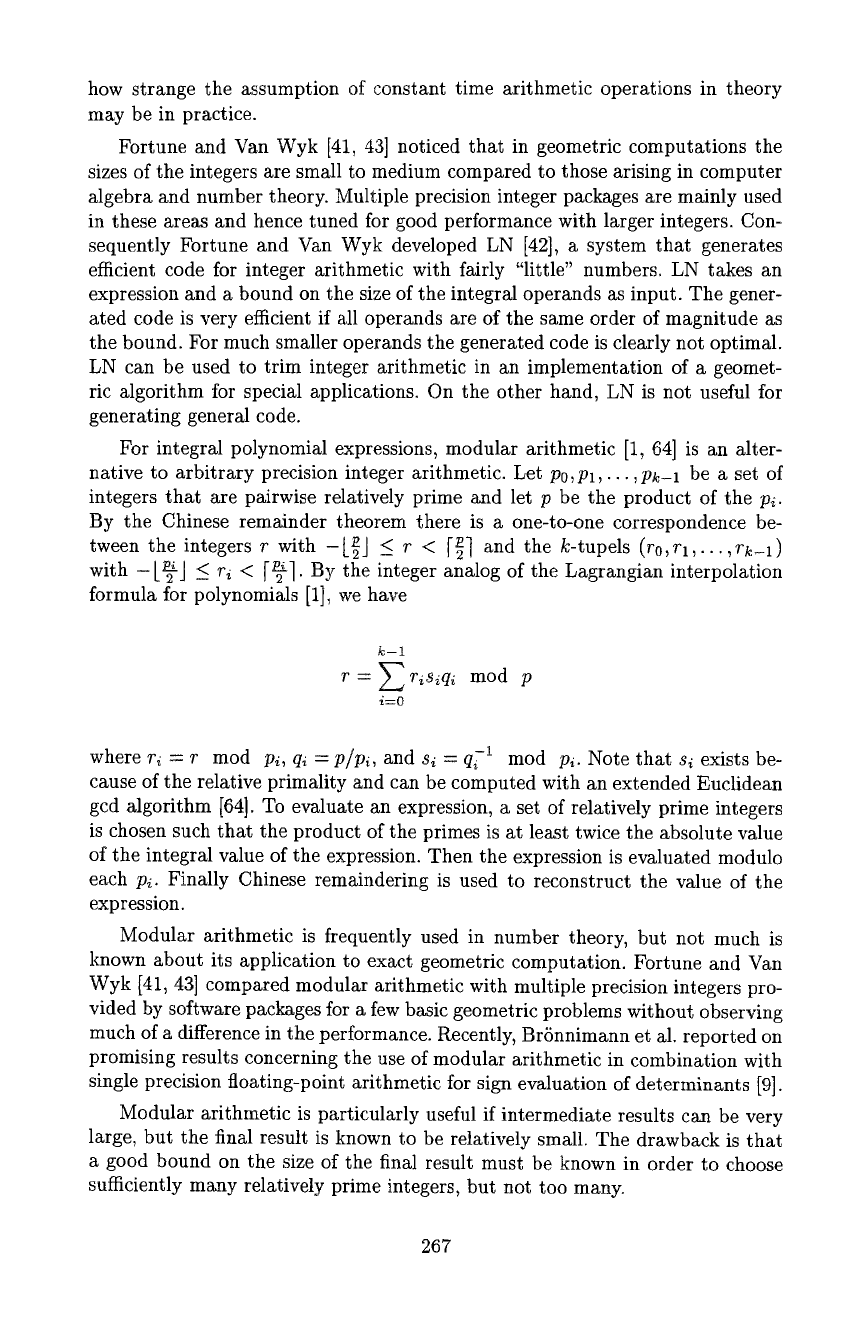
how strange the assumption of constant time arithmetic operations in theory
may be in practice.
Fortune and Van Wyk [41, 43] noticed that in geometric computations the
sizes of the integers are small to medium compared to those arising in computer
algebra and number theory. Multiple precision integer packages are mainly used
in these areas and hence tuned for good performance with larger integers. Con-
sequently Fortune and Van Wyk developed LN [42], a system that generates
efficient code for integer arithmetic with fairly "little" numbers. LN takes an
expression and a bound on the size of the integral operands as input. The gener-
ated code is very efficient if all operands are of the same order of magnitude as
the bound. For much smaller operands the generated code is clearly not optimal.
LN can be used to trim integer arithmetic in an implementation of a geomet-
ric algorithm for special applications. On the other hand, LN is not useful for
generating general code.
For integral polynomial expressions, modular arithmetic [1, 64] is an alter-
native to arbitrary precision integer arithmetic. Let P0,pl,...,Pk-1 be a set of
integers that are pairwise relatively prime and let p be the product of the p~.
By the Chinese remainder theorem there is a one-to-one correspondence be-
tween the integers r with -[2~] _< r < [2 ~] and the k-tupels (r0,h,...,rk_l)
with -L~] < r~ < [9]' By the integer analog of the Lagrangian interpolation
formula for polynomials [1], we have
r=~risiq.i
mod p
i=0
where r~ = r mod p~, q~ =
p/p~,
and s~ = q~-i mod p~. Note that s~ exists be-
cause of the relative primality and can be computed with an extended Euclidean
gcd algorithm [64]. To evaluate an expression, a set of relatively prime integers
is chosen such that the product of the primes is at least twice the absolute value
of the integral value of the expression. Then the expression is evaluated modulo
each p~. Finally Chinese remaindering is used to reconstruct the value of the
expression.
Modular arithmetic is frequently used in number theory, but not much is
known about its application to exact geon~mtric computation. Fortune and Van
Wyk [41, 43] compared modular arithmetic with multiple precision integers pro-
vided by software packages for a few basic geometric problems without observing
much of a difference in the performance. Recently, Brhnnimann et al. reported on
promising results concerning the use of modular arithmetic in combination with
single precision floating-point arithmetic for sign evaluation of determinants [9].
Modular arithmetic is particularly useful if intermediate results can be very
large, but the finM result is known to be relatively small. The drawback is that
a good bound on the size of the final result must be known in order to choose
sufficiently many relatively prime integers, but not too many.
267
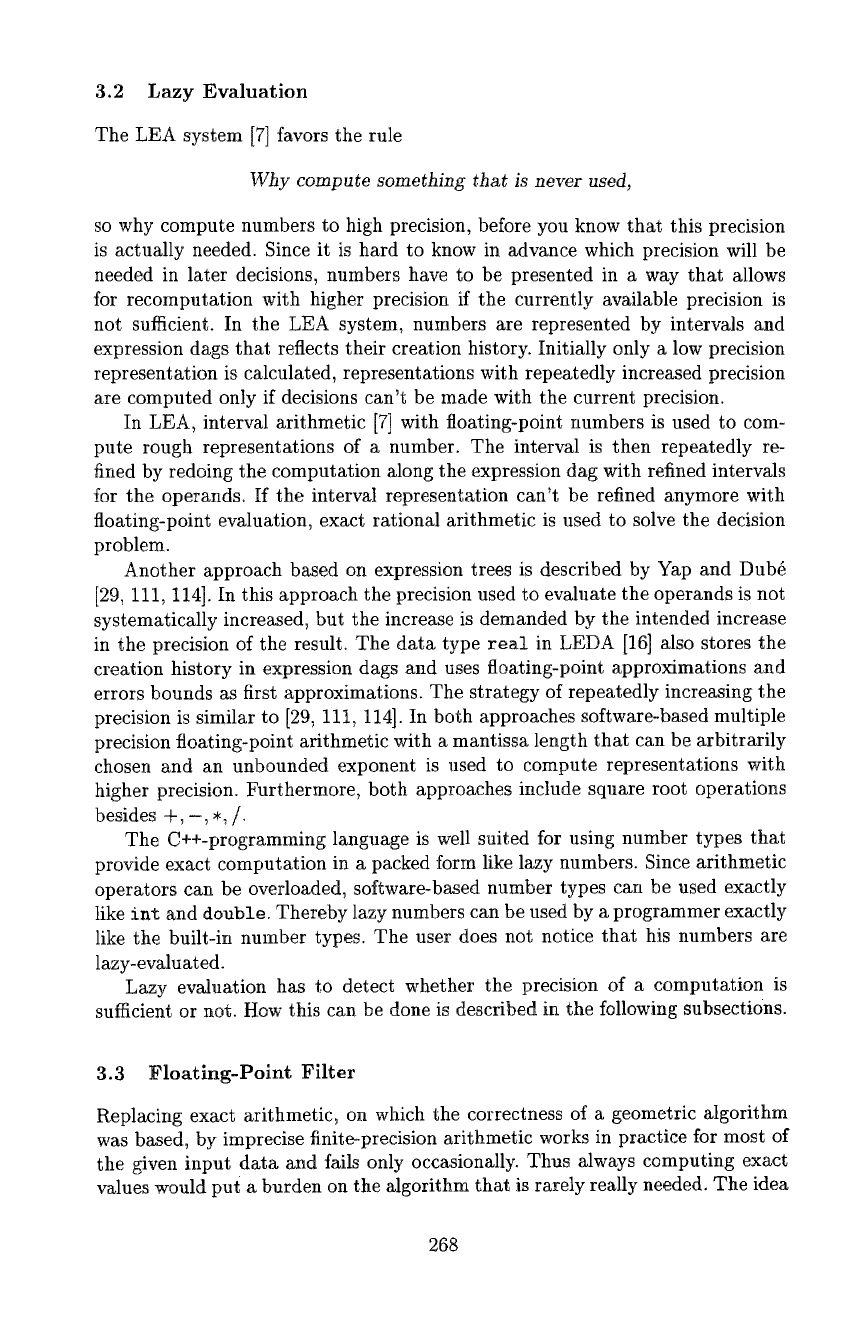
3.2 Lazy Evaluation
The LEA system [7] favors the rule
Why compute something that is never used,
so why compute numbers to high precision, before you know that this precision
is actually needed. Since it is hard to know in advance which precision will be
needed in later decisions, numbers have to be presented in a way that allows
for recomputation with higher precision if the currently available precision is
not sufficient, tn the LEA system, numbers are represented by intervals and
expression dags that reflects their creation history. Initially only a low precision
representation is calculated, representations with repeatedly increased precision
are computed only if decisions can't be made with the current precision.
In LEA, interval arithmetic [71 with floating-point numbers is used to com-
pute rough representations of a number. The interval is then repeatedly re-
fined by redoing the computation along the expression dug with refined intervals
for the operands. If the interval representation can't be refined anymore with
floating-point evaluation, exact rational arithmetic is used to solve the decision
problem.
Another approach based on expression trees is described by Yap and Dub~
[29, 111,114]. In this approach the precision used to evaluate the operands is not
systematically increased, but the increase is demanded by the intended increase
in the precision of the result. The data type real in LEDA [16] also stores the
creation history in expression dags and uses floating-point approximations and
errors bounds as first approximations. The strategy of repeatedly increasing the
precision is similar to [29, 111,114]. In both approaches software-based multiple
precision floating-point arithmetic with a mantissa length that can be arbitrarily
chosen and an unbounded exponent is used to compute representations with
higher precision. Furthermore, both approaches include square root operations
besides +, -, *,/.
The C++-programming language is well suited for using number types that
provide exact computation in a packed form like lazy numbers. Since arithmetic
operators can be overloaded, software-based number types can be used exactly
like ±at and double. Thereby lazy numbers can be used by a programmer exactly
like the built-in number types. The user does not notice that his numbers are
lazy-evaluated.
Lazy evaluation has to detect whether the precision of a computation is
sufficient or not. How this can be done is described in the following subsections.
3.3 Floating-Point Filter
Replacing exact arithmetic, on which the correctness of a geometric algorithm
was based, by imprecise finite-precision arithmetic works in practice for most of
the given input data and fails only occasionally. Thus always computing exact
values would putl a burden on the algorithm that. is rarely really needed. The idea
268

of floating-point filters is to filter out those branching steps where a floating-point
computation gives the correct result. Only if it is not certified that the floating-
point evaluation leads to a correct decision is the branching step reevaluated at
a higher cost by calculating the exact value or a better approximation.
Filter techniques allow the use of high speed floating-point arithmetic. A
filter simply computes a bound on the error of the floating-point computation
and compares the absolute value of the coInputed result to the computed error
bound. If the error bound is smaller, the computed approximation and the exact
value have the same sign. Error bounds can be computed a priori if specific
information on the input data is available, e.g., if all input data are integers
from a bounded range, e.g., the range of integers representable in a computer
word. Such so-called static filters require only little additional effort at run time,
just one additional test per branching, plus the refined reevaluation in the worst
case. Dynamic filters compute an error bound on the fly parallel to the evaluation
in floating point arithmetic. Since they take the actual values of the operands
into account and not only bounds derived from the bounds on the input data,
the estimates for the error involved in the floating-point computation can be
much tighter than in a static filter. Thus dynamic filters can let more floating-
point calculations pass the filter but at the cost of the online error computation.
In the error computation one can put emphasis on speed or on precision. The
former makes arithmetic operations more efficient while the latter lets more
floating-point computations pass a test.
Note the difference between static filters and heuristic epsilons. If the com-
puted approximate value is larger than the error bound or em~gi~ respectively, the
behavior is identical. The program continues based on the assumption that the
computed floating-point value has the correct sign. If, however, the computed
approximate value is too small, the behavior is completely different. Epsilon-
tweaking assumes that the actual value is zero, which might be wrong, while a
floating-point filter invokes a more expensive computation, which finally leads
to a correct decision.
Mehlhorn and N/iher use the following easily computable error bounds for in-
tegral expressions evaluated in floating-point arithmetic in their implementation
of the Bentley-Ottmann plane sweep algorithm for computing the intersections
among a set of line segments in the plane [71]. It assumes that neither overflow
nor underflow occurs. Let E be an integral expression. E is also used to denote
the value of E while/) is used to denote the value of the expression when eval-
uated with floating point arithmetic, i.e., all operations are replaced by their
floating point counterparts.
Mehlhorn and N£her [71] define the
measure rues(E)
and the
index ind(E)
of a polynomial expression E such that
IE, - Et <_ ind(E) " cprec " rues(E).
269
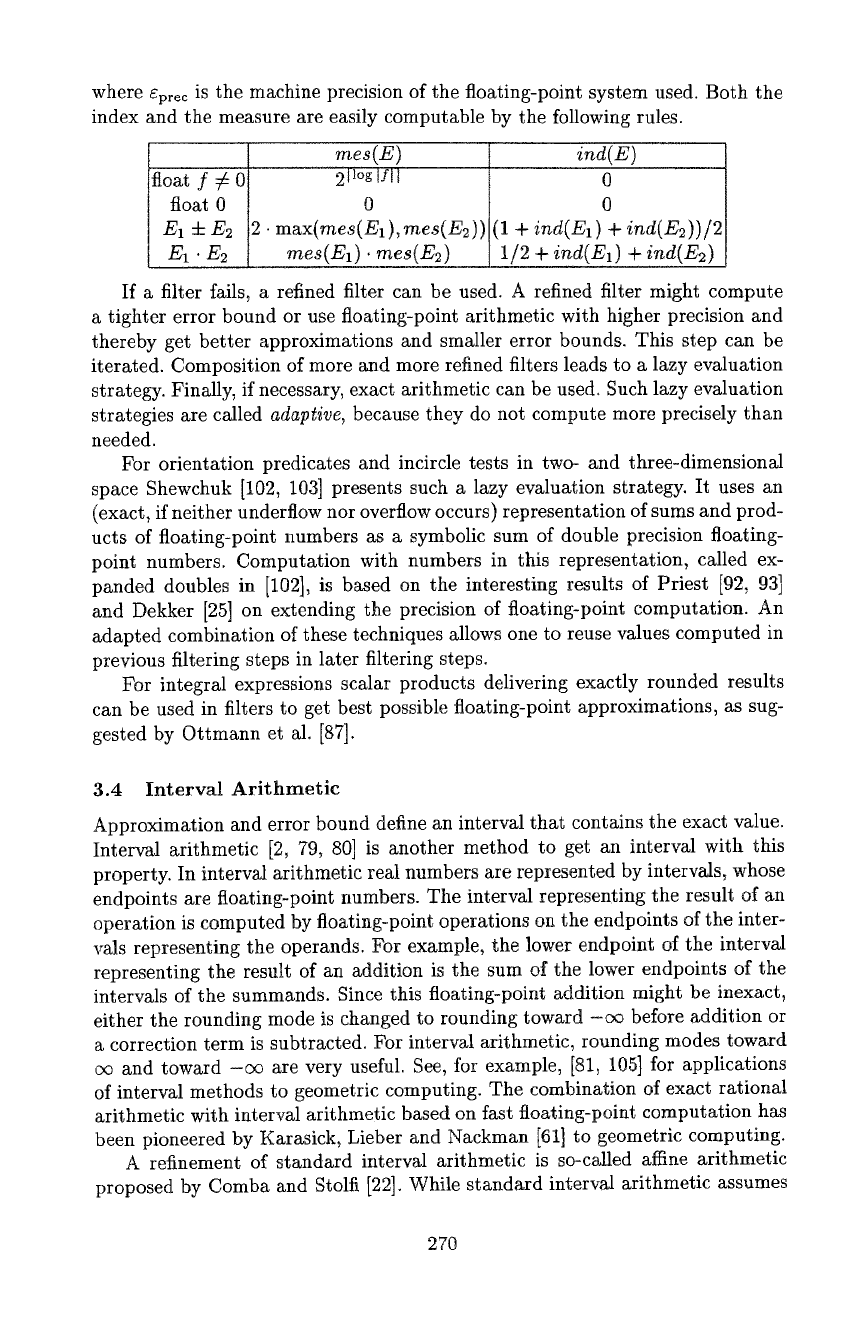
where gprec is the machine precision of the floating-point system used. Both the
index and the measure are easily computable by the following rules.
t ] mes(E) ind!
E)
float f # 0
float 0 , .....
2-~0 f'l I
E1 ! E2 2. max(mes(E1),mes(E2))l(1 + ind(E1) + ind(E2))/2]
Et . E2
,,
mes(Ei) . mes(E2)
[ 1:/2 +
ind(Ei) + ind(E2) ]
If a filter fails, a refined filter can be used. A refined filter might compute
a tighter error bound or use floating-point arithmetic with higher precision and
thereby get better approximations and smaller error bounds. This step can be
iterated. Composition of more azld more refined filters leads to a lazy evaluation
strategy. Finally, if necessary, exact arithmetic can be used. Such lazy evaluation
strategies are called
adaptive,
because they do not compute more precisely than
needed.
For orientation predicates and incircle tests in two- and three-dimensional
space Shewchuk [102, 103] presents such a lazy evaluation strategy. It uses an
(exact, if neither underflow nor overflow occurs) representation of sums and prod-
ucts of floating-point numbers as a symbolic sum of double precision floating-
point numbers. Computation with numbers in this representation, called ex-
panded doubles in [102], is based on the interesting results of Priest [92, 93]
and Dekker [25] on extending the precision of floating-point computation. An
adapted combination of these techniques allows one to reuse values computed in
previous filtering steps in later filtering steps.
For integral expressions scalar products delivering exactly rounded results
can be used in filters to get best possible floating-point approximations, as sug-
gested by Ottmann et al. [87].
3.4 Interval Arithmetic
Approximation and error bound define an interval that contains the exact value.
Interval arithmetic [2, 79, 80] is another method to get an interval with this
property. In interval arithmetic real numbers are represented by intervals, whose
endpoints are floating-point numbers. The interval representing the result of an
operation is computed by floating-point operations on the endpoints of the inter-
vals representing the operands. For example, the lower endpoint of the interval
representing the result of an addition is the sum of the lower endpoints of the
intervals of the summands. Since this floating-point addition might be inexact,
either the rounding mode is changed to rounding toward -cx~ before addition or
a correction term is subtracted. For interval arithmetic, rounding modes toward
and toward -oo are very useful. See, for example, [81, 105] for applications
of interval methods to geometric computing. The combination of exact rational
arithmetic with interval arithmetic based on fast floating-point computation has
been pioneered by Karasick, Lieber and Nackman [61] to geometric computing.
A refinement of standard interval arithmetic is so-called affine arithmetic
proposed by Comba and Stolfi [22]. While standard interval arithmetic assumes
270
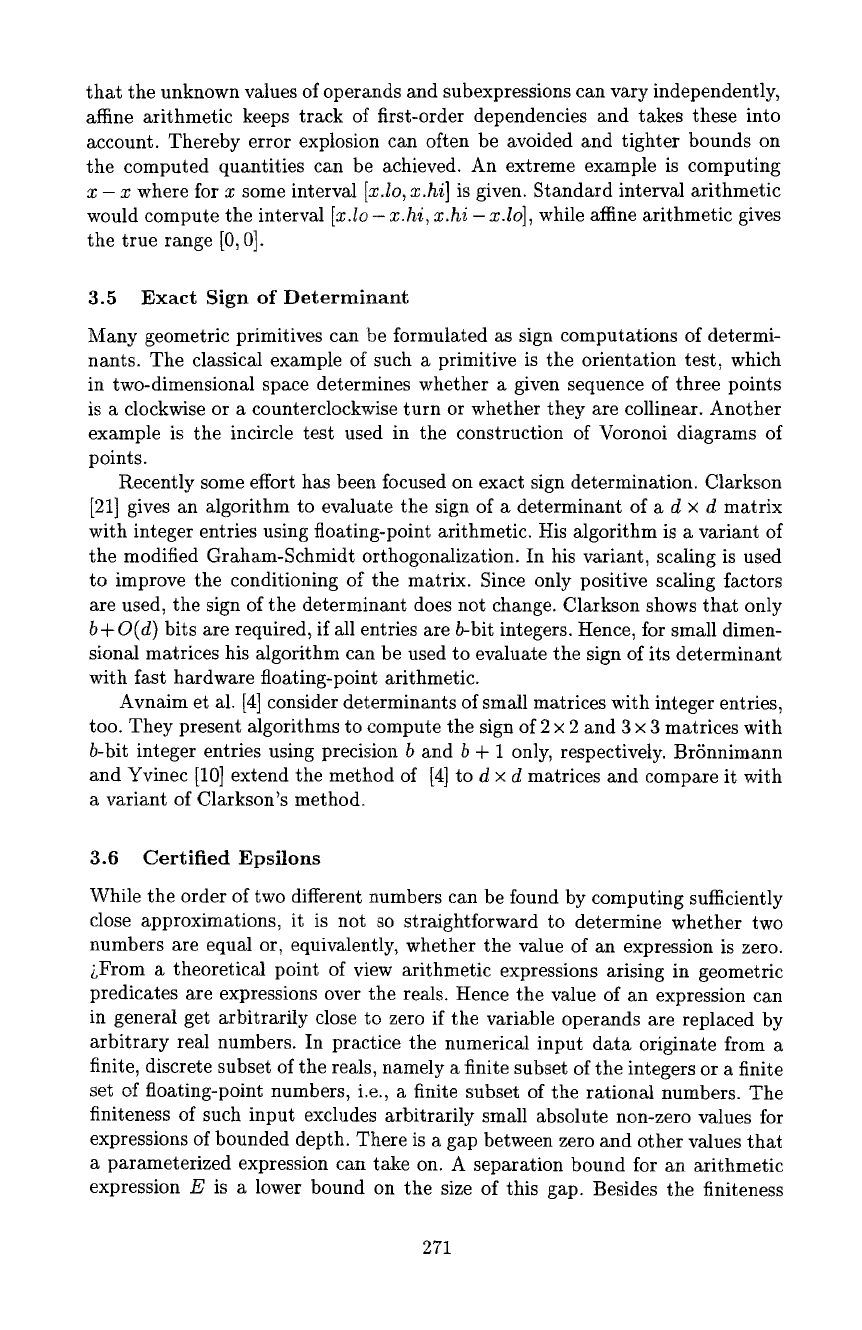
that the unknown values of operands and subexpressions can vary independently,
affine arithmetic keeps track of first-order dependencies and takes these into
account. Thereby error explosion can often be avoided and tighter bounds on
the computed quantities can be achieved. An extreme example is computing
x - x where for x some interval
[x.lo, x.hi]
is given. Standard interval arithmetic
would compute the interval
[x.lo- x.hi, x.hi- x.lo],
while affine arithmetic gives
the true range [0, 0].
3.5 Exact Sign of Determinant
Many geometric primitives can be formulated as sign computations of determi-
nants. The classical example of such a primitive is the orientation test, which
in two-dimensional space determines whether a given sequence of three points
is a clockwise or a counterclockwise turn or whether they are collinear. Another
example is the incircle test used in the construction of Voronoi diagrams of
points.
Recently some effort has been focused on exact sign determination. Clarkson
[21] gives an algorithm to evaluate the sign of a determinant of a d × d matrix
with integer entries using floating-point arithmetic. His algorithm is a variant of
the modified Graham-Schmidt orthogonatization. In his variant, scaling is used
to improve the conditioning of the matrix. Since only positive scaling factors
are used, the sign of the determinant does not change. Clarkson shows that only
b+O(d)
bits are required, if all entries are b-bit integers. Hence, for small dimen-
sional matrices his algorithm can be used to evaluate the sign of its determinant
with fast hardware floating-point arithmetic.
Avnaim et al. [4] consider determinants of small matrices with integer entries,
too. They present algorithms to compute the sign of 2 × 2 and 3 × 3 matrices with
b-bit integer entries using precision b and b + 1 only, respectively. BrSnnimann
and Yvinec [10] extend the method of [4] to d × d matrices and compare it with
a variant of Clarkson's method.
3.6 Certified Epsilons
While the order of two different numbers can be found by computing sufficiently
close approximations, it is not so straightforward to determine whether two
numbers are equal or, equivalently, whether the value of an expression is zero.
/.From a theoretical point of view arithmetic expressions arising in geometric
predicates are expressions over the reals. Hence the value of an expression can
in general get arbitrarily close to zero if the variable operands are replaced by
arbitrary real numbers. In practice the numerical input data originate from a
finite, discrete subset of the reals, namely a finite subset of the integers or a finite
set of floating-point numbers, i.e., a finite subset of the rational numbers. The
finiteness of such input excludes arbitrarily small absolute non-zero values for
expressions of bounded depth. There is a gap between zero and other values that
a parameterized expression can take on. A separation bound for an arithmetic
expression E is a lower bound on the size of this gap. Besides the finiteness
271
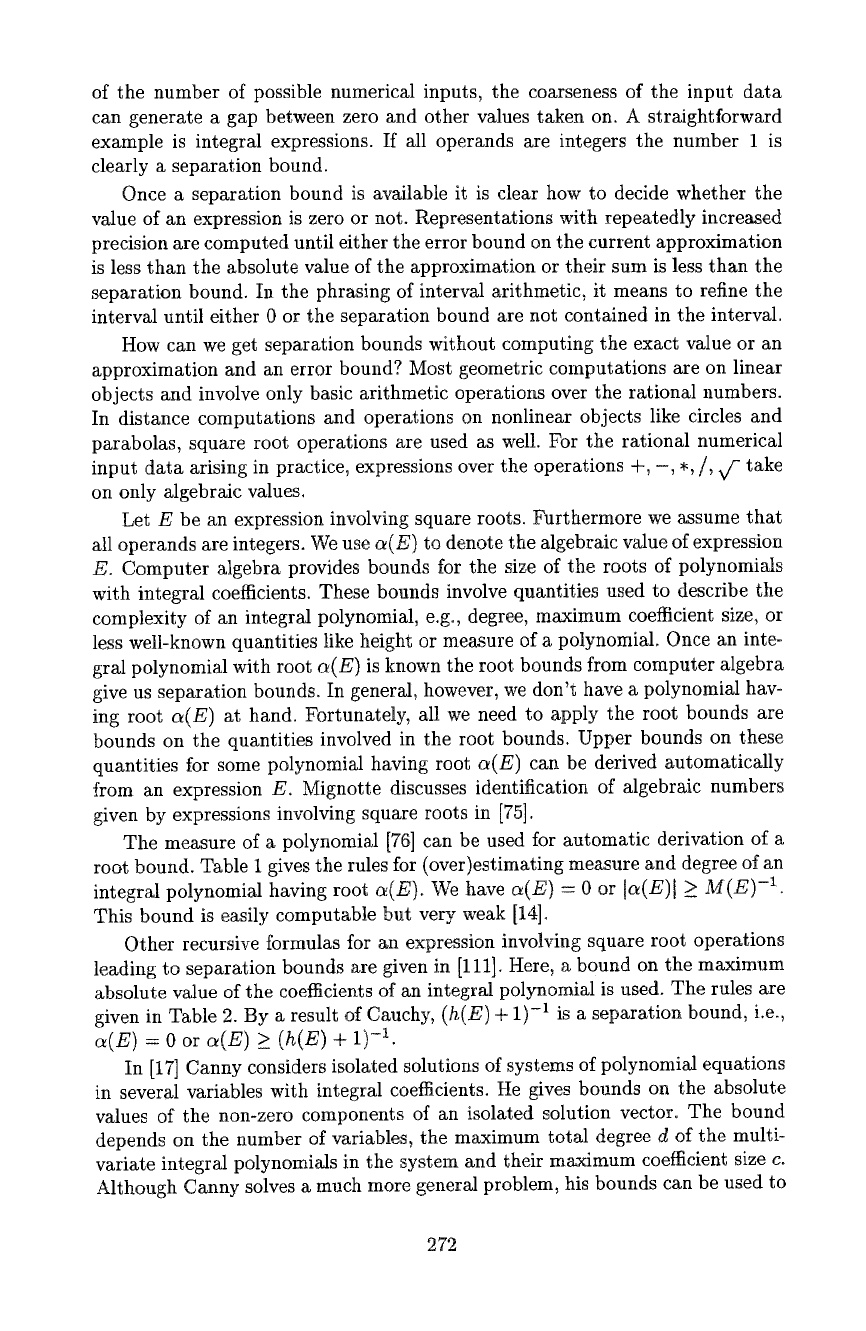
of the number of possible numerical inputs, the coarseness of the input data
can generate a gap between zero and other values taken on. A straightforward
example is integral expressions. If all operands are integers the number 1 is
clearly a separation bound.
Once a separation bound is available it is clear how to decide whether the
value of an expression is zero or not. Representations with repeatedly increased
precision are computed until either the error bound on the current approximation
is less than the absolute value of the approximation or their sum is less than the
separation bound. In the phrasing of interval arithmetic, it means to refine the
interval until either 0 or the separation bound are not contained in the interval.
How can we get separation bounds without computing the exact value or an
approximation and an error bound? Most geometric computations are on linear
objects and involve only basic arithmetic operations over the rational numbers.
In distance computations and operations on nonlinear objects like circles and
parabolas, square root operations are used as well. For the rational numerical
input data arising in practice, expressions over the operations +, -, *,/, x/- take
on only algebraic values.
Let E be an expression involving square roots. Furthermore we assume that
all operands are integers. We use a(E) to denote the algebraic value of expression
E. Computer algebra provides bounds for the size of the roots of polynomials
with integral coefficients. These bounds involve quantities used to describe the
complexity of an integral polynomial, e.g., degree, maximum coefficient size, or
less well-known quantities like height or measure of a polynomial. Once an inte-
gral polynomial with root a(E) is known the root bounds from computer algebra
give us separation bounds. In general, however, we don't have a polynomial hav-
ing root a(E) at hand. Fortunately, all we need to apply the root bounds are
bounds on the quantities involved in the root bounds. Upper bounds on these
quantities for some polynomial having root a(E) can be derived automatically
from an expression E. Mignotte discusses identification of algebraic numbers
given by expressions involving square roots in [75].
The measure of a polynomial [76] can be used for automatic derivation of a
root bound. Table I gives the rules for (over)estimating measure and degree of an
integral polynomial having root
a(E). We
have
a(E)
: 0 or [a(E)[ _>
M(E) -1.
This bound is easily computable but very- weak [14].
Other recursive formulas for an expression involving square root operations
leading to separation bounds are given in [111]. Here, a bound on the maximum
absolute value of the coefficients of an integral polynomial is used. The rules are
given in Table 2. By a result of Cauchy,
(h(E) +
1) -~ is a separation bound, i.e.,
a(E)
= 0 or
a(E) >_ (h(E) +
1) -1.
In [17] Canny considers isolated solutions of systems of polynomial equations
in several variables with integral coefficients. He gives bounds on the absolute
values of the non-zero components of an isolated solution vector. The bound
depends on the number of variables, the maximum total degree d of the multi-
variate integral polynomials in the system and their maximum coefficient size c.
Although Canny solves a much more general problem, his bounds can be used to
272
